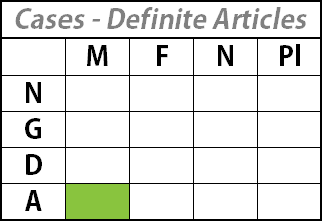

Ask yourself “Who” is doing the action (expressed by the verb). The nominative singular is the the starting point in any learner’s German case endings adventure. The four German cases and when they are used Nominative Changes like these are called verb “conjugation”.īefore we look in detail at German case endings, let’s get a quick overview at the four German cases and what each one is used for. Verb endings show who did action (me, you, they etc) and when (I work > I worked), for example. Grammarians call the way the endings change to show case in German (and many other languages) “declension”.ĭon’t confuse declension with the endings that we add to verbs (words expressing action like “to eat” or a state “to be”). In English, adjectives don’t change to show case at all (though some adjectives get the ending -er in English when we’re comparing two nouns or pronouns (big > bigger). As we’ll see, they also change to show the case.Īdjectives are describing words that tell you more about a noun (or a pronoun). In German, in contrast, determiner endings change to show gender, singular or plural (der, die, das, die). Some of these determiners change their form in English to show a plural: this > these but otherwise, in English, they are fixed. the dog), “I saw a few” (dogs) not “I like the”. Unlike the articles, these other determiners can also be used instead of the noun (as pronouns): Other determiners are demonstratives (diese, jene this/that), possessives (mein, unser/my, our) and some indefinites (einige/a few, manche/some and so on). They show that we’re talking about a “non-specific” example of the thing known as “dog” or “Hund”. In German, as in English, there’s a definite article that is put before a noun to make clear that we’re talking about a specific or “definite” example of it: not a dog/ein Hund but the dog/der Hund. First among the determiners are the articles. These are words that “narrow down” a noun. But the German case-ending action mainly affects two other groups of words. It’s the same in English: “he” becomes “him” or “his”, “we” becomes “us” or “our” and so on. Yes, when pronoun takes the place of a noun, there are case-specific forms (“er” > “ihn”, “ihm” “wir” > “uns”). In German, it’s not usually the noun (name a living being, thing or idea) itself that gets an ending. German also expresses case by changing the endings of words but it does so much more frequently than today’s English (the -’s ending there is an example of the English “possessive case”, by the way). For example who does what to whom or whose this or that is.Ī thousand years ago, Old English had a full case system and we can see some of its remnants in the way that “who” gains case endings to change to “who m” or “who se”. In short, the job of case is to show the role of a noun (person or thing) or a pronoun representing a person or thing in relation to other nouns in a phrase. Meet the four German cases! There’s no denying that the extra “moving parts” complicate German for learners but, if you take time to understand how the system works, you’ll see that the cases can be conquered 🙂 Hold on, though! What even is “case”? What are the different cases for? Which case ending do I need? How do I remember them? This post will give you the answers and set you up to start practising the cases with confidence and to get those endings RIGHT! Discover how YOU can use Dr P's free Weekly Workout Routine to get ready for more confident German conversations in a matter of weeks. You won’t get far into your German learning journey without noticing some words change their form in ways that seem strange for an English native.


 0 kommentar(er)
0 kommentar(er)
